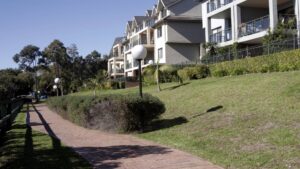Each year, Fire & Rescue NSW responds to many fires in apartment buildings – reinforcing the need for effective, reliable and up-to-date Essential Fire Safety Measures. Essential fire safety measures are the fire safety systems required by the Building Code of Australia to be installed in commercial, industrial and public buildings, boarding houses, hostels and bed & breakfasts to ensure the safety of occupants within the building in the event of a fire or emergency. They perform a vital function in protecting life, and property and preventing injury in the event of fire.
A fire safety schedule, interim/final fire safety certificate or annual fire safety statement issued for the building lists all the essential fire safety measures that are installed in the building and the performance standard to which each of those measures must be capable of operating. Building owners and managing agents need to be aware of these vital fire safety requirements. Failure to comply is an offence and will render the owner liable to substantial penalties. More importantly, a failure to meet these requirements can significantly affect the levels of fire safety afforded to the occupants of the building, which may threaten their life safety, as well as have significant liability implications for the building owner.
“At BMA we have over 30 years in building management and know that the efficacy of all fire safety measures depends largely on their management and maintenance,” says Ben Mees, BMA General Manager. “Our building managers prioritise fire safety and ensure their building’s fire safety measures are not overlooked and operate as they should in the event of a fire. And while this gives residents peace of mind, their knowledge of the relevant legal requirements relating to fire safety measures makes obtaining Annual Fire Safety Statements a smoother, less stressful process for Owners Corporations and Strata Managers.”
Annual Fire Safety Statements
The Annual Fire Safety Statement (AFSS) is proof that your building’s Essential Fire Safety Measures have been checked and maintained to the Australian Standards and Regulations over the past 12 months.
Once an AFSS is secured, it is lodged and displayed rather than filed away. BMA building managers ensure their buildings stay compliant by submitting a copy of the AFSS to the local council and Fire and Rescue NSW (FRNSW), along with a copy of the building’s fire safety schedule, and displaying a copy of the statement and building fire safety schedule in their building where it can be easily viewed by everyone. These steps are crucial as they are a legal requirement of building owners, and those who overlook this responsibility face fines.
Is your building’s fire safety in good hands?
Forgetting to submit your building’s AFSS and putting its fire safety measures, such as smoke detection and alarm systems, in the hands of incompetent and deceptive contractors and inspectors risks the health and safety of residents and can affect insurance payouts in the event of a fire.
“In a typical apartment building there is a variety of fire safety measures that all need maintaining and monitoring, such as smoke detectors, alarm systems, fire doors, automatic sprinkler systems, and emergency lights and exit signs,” explains Ben Mees, BMA General Manager. “Our building managers ensure a building’s AFSS is current and all its fire safety measures are in good working condition, by scheduling routine maintenance and inspections by qualified, competent and accredited contractors. The AFSS is a condition for insurance coverage – without insurance coverage, you cannot occupy a building.
Competent Fire Safety Practitioners
Building owners and Managing Agents are required by the Environmental Planning and Assessment Regulation 2000 to select Competent Fire Safety Practitioners (CFSP) to assess their building’s fire safety measures to obtain an AFSS.
As selecting a CFSP can be challenging because their competence is largely based on individual experience and skill, the NSW Government recommends the following to help determine competence:
1. Identify tasks that the fire safety practitioner will need to perform.
2. Consider the fire safety practitioner’s competence to perform those tasks, including knowledge, skills, and experience.
3. Establish and record an opinion of the practitioner’s competence.
Navigating the fire safety requirements maze
At BMA, we know how expensive, frustrating and time-consuming it can be to navigate the NSW government’s complex fire safety requirements, ensuring your building’s fire safety measures are maintained to a high standard by the right contractors, and securing and lodging the AFSS on time.
“Our building managers are skilled in obtaining AFSS certificates for lodgement to local councils and the FRNSW, assisting with determining the competence of maintenance contractors, reviewing condition reports and quotes, managing contractors, and inspecting their work,” adds Mees.




